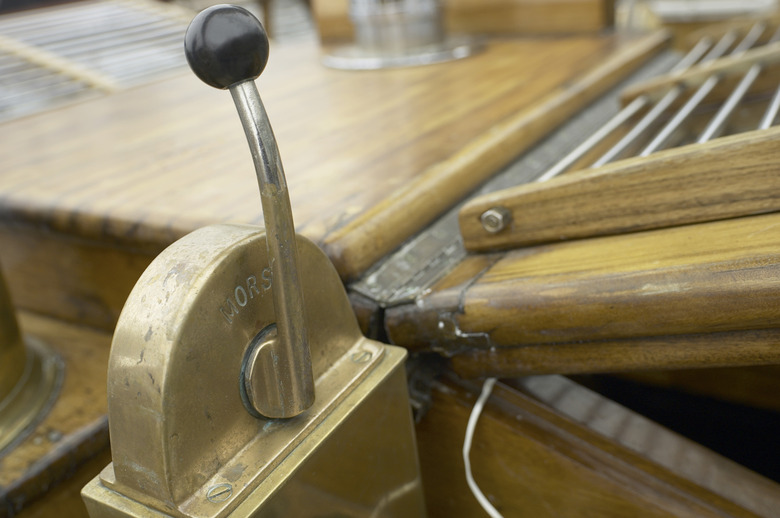Ten Different Types Of Levers
Simple machines provide mechanical advantages. In simpler terms, simple machines make work easier by increasing the amount of work done with a certain effort or by decreasing the amount of effort required to do the same work. Work, by definition, equals force times distance. The simple machine known as a lever comes in three variations, each of which performs work by increasing the effectiveness of an applied force.
TL;DR (Too Long; Didn't Read)
Examples of levers in everyday life include teeter-totters, wheelbarrows, scissors, pliers, bottle openers, mops, brooms, shovels, nutcrackers and sports equipment like baseball bats, golf clubs and hockey sticks. Even your arm can act as a lever.
Work, Force and Distance
Work, Force and Distance
The work done by levers usually changes the direction of the applied force, the distance and speed of movement produced by the applied force or the effective strength of the applied force. Levers use a bar to transfer an effort (applied force) through a fulcrum (focused point) to a load or resistance. The relative positions of these three elements of a lever determines whether the lever is a first-class or first-order lever, a second-class or second-order lever or a third-class or third-order lever.
First-Class Levers
First-Class Levers
First-class (also called first-order) levers have the applied force on one side of the fulcrum and the load or resistance on the other side of the fulcrum. Moving the fulcrum closer to the load end increases the effectiveness of the force from the effort end. These types of levers may be the most easily recognized levers.
Second-Class Levers
Second-Class Levers
Second-class (or second-order) levers have the applied force on one end of the lever and the fulcrum on the other side of the lever. The load or resistance lies between the fulcrum and the applied force.
Third-Class Levers
Third-Class Levers
Third-class (or third-order) levers have the load at one end of the lever and the fulcrum at the other end of the lever. The applied force occurs between the load and the fulcrum.
Ten Types of Levers
Ten Types of Levers
First=Class Lever Examples
A seesaw or teeter-totter may be the most commonly recognized first-order lever. The downward applied force of the rider at one end of the seesaw translates across the fulcrum to lift the rider at the other end. Moving the fulcrum closer to a larger rider increases the effectiveness of the force from a smaller rider.
Scissors are another common first-order lever. The handles apply the force or effort, the screw connecting the two sides forms the fulcrum and the force transferred to the blades allows the scissors to cut.
Like scissors, pliers work as first-order levers by applying a force at the handles. The hinged middle works as a fulcrum, and the load or resistance occurs between the teeth of the pliers.
Second-Class Lever Examples
Wheelbarrows are examples of second-order levers. The wheel serves as the fulcrum. The applied force occurs at the handles. The load, of course, lies between the force and the fulcrum.
A classic hand-held nutcracker also is a second-order lever. The hinged end serves as the fulcrum. Force applied to the ends of the handles cracks the nut (load) that lies between.
A hand-held bottle opener acts as a second-order lever. Force is applied at one end of the opener in an effort to overcome the resistance of the bottle cap. The fulcrum lies at the end of the opener resting on the bottle cap.
Third-Class Lever Examples
Third-order levers include many kinds of sporting equipment, including baseball bats, golf clubs and hockey sticks. You hold these with both of your hands, but one merely holds the item while the other applies more force. So, all three of these examples have the fulcrum at one end, where one of your hands holds the lever (meaning the club, stick and so on). The applied force occurs near the fulcrum, where your other hand applies effort so that the force moves the opposite end of the item, transferring the force to the baseball, golf ball or hockey puck.
Lifting an apple uses a third-order lever – your arm! The elbow serves as the fulcrum, the applied force comes from the muscles and the apple or load is lifted.
A shovel works as a third-order lever. Like the hockey stick, the hand closest to the end acts as the fulcrum, the second hand provides effort and the shovel end lifts and moves the load.
Brooms and mops also act as third-order levers. The upper hand serves as the fulcrum, the lower hand provides the force and the broom or mop end pushes against the resistance of the dirt and floor.
Cite This Article
MLA
Blaettler, Karen G. "Ten Different Types Of Levers" sciencing.com, https://www.sciencing.com/ten-different-types-levers-7285923/. 15 December 2020.
APA
Blaettler, Karen G. (2020, December 15). Ten Different Types Of Levers. sciencing.com. Retrieved from https://www.sciencing.com/ten-different-types-levers-7285923/
Chicago
Blaettler, Karen G. Ten Different Types Of Levers last modified March 24, 2022. https://www.sciencing.com/ten-different-types-levers-7285923/
